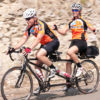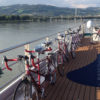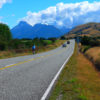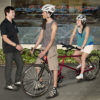
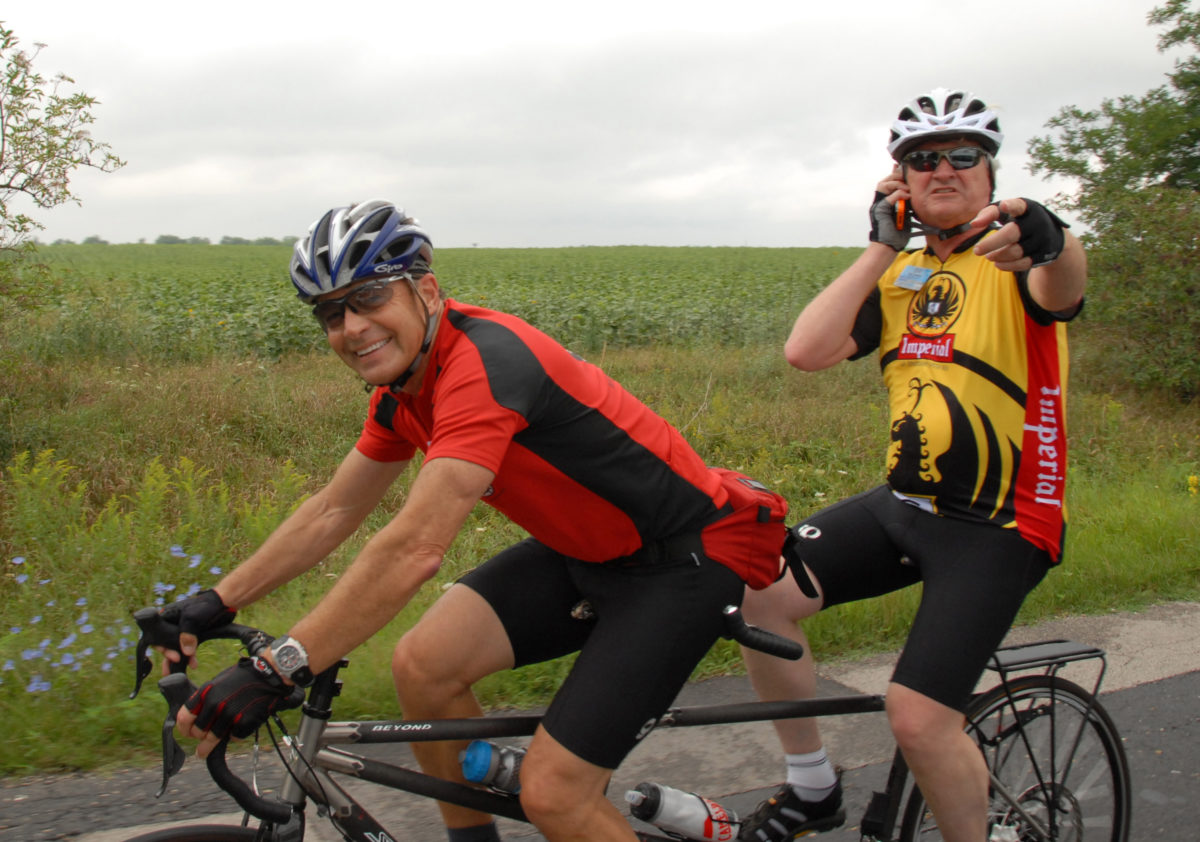
Jan and I have checked tandems onto over 250 flights. We often fly with multiple tandems and have never missed a flight or left a bike behind. Since 1986 we’ve coached thousands who have flown with their tandems to Santana’s events. The 1000-plus couples who flew to our 2010-2013 events posted a perfect 100% success rate for flying with their tandems.
Are you afraid of being hassled, overcharged, or even turned away? This guide’s for you!
As will be explained more fully below, airline rules have changed and will continue to evolve.
While some of us wistfully recall when bike fees were lower, it’s usually less expensive to fly now than when bikes were checked for free. Although bike owners tend to agonize over the cost of flying with bikes to a cycling vacation, it’s generally cheaper to take bikes than to rent a car. Better yet, flying with a tandem costs half as much as flying with two singles.
SECTION ONE
Traveling with a normal tandem
If your tandem fits in suitcase-sized containers, skip to Section Two
In spite of horror stories, there is no reason to imagine that you can’t fly with a full-sized tandem. While newer coupled tandems have made it easier to get to-and-from airports, full-sized tandems continue to be accepted as checked luggage. Couples who use my time-tested tips continue to report a 100% success rate.
1. Don’t phone the airline.
Airline phone operators will needlessly scare you by reciting the luggage limitations dictated by their smallest prop-liner or regional jet.
2. Ignore a website’s size restriction.
These days, when Jan and I finally convince insecure tandem owners to NOT phone the airline, their immediate response is to run to the web. Although we’ll explain later why this is much safer than using the phone, please don’t expect reassurance. Because the big airlines don’t want you to avoid their “feeder flights” using teensy sub-contracted planes flown by non-union crews, they’ll never tell you that full-size tandems are easily accommodated on all of their normal planes (and by competitors who use normal planes on the same route). Instead, they’ll publish the too-small limitations of the tiniest plane they subcontract.
The only airline that publishes different dimensions for different airliners (United) welcomes larger sporting items on flights with a Boeing 757, and then claims these same items won’t fit on a Boeing 737—which has an identically roomy baggage compartment! If your reason for web research is to feel “safe,” please don’t waste your time.
The airline employees who write bicycle size regulations don’t work at an airport. The airline employees who work at the airport ignore stupid regulations. The real issue is explained below.
3. Don’t phone the airline.
If enough cyclists bother them, the airlines will respond by making it tougher and more expensive to fly with a bicycle. While the existing system is unpredictable and confused, it works just fine for tandem enthusiasts who learn how to avoid the pitfalls. Keep reading.
4. Book the right flights.
Because the largest tandem cases won’t fit in the smallest “regional” airliners, the size of your tandem case dictates your choice of flights (and may limit your choice of airports). Even the largest tandem case or box easily fits within the luggage bays found on airliners big enough for 5-across economy seating. Tandem cases from BikePro USA and Crateworks barely fit in planes with 4-across seating, which may cause your bike to be delayed if your case shows up after the plane is partially loaded. Unless your tandem stows in a suitcase-sized container, you must avoid flights on planes with 3-across seating. Jan and I research our flights on Orbitz.com, a website where seating charts reveal everything you’ll need to know in order to book appropriate flights.
5. Should you worry about a 70-pound (32kg) limit for bike cases?
In the “Good Old Days” suitcases could weigh up to 70 pounds and everything else could weigh up to 99 pounds. Since 2003 most airlines have imposed a surcharge for suitcases weighing over 50 pounds. Since 2006 we’ve seen a growing trend to limit all checked items to 70 pounds. If your tandem case needs to exceed 70 pounds, find the “sporting equipment” rules on an airline’s website. While I would not worry about a weight limitation specific to bicycles, a published ban on all sporting equipment over 70 pounds would cause me pack a tandem differently.
London’s Gatwick and Heathrow airports are trying to stem injury claims of their luggage handlers by not allowing “sporting equipment” over 70 pounds to be checked at either airport UNLESS 24 hours notice is provided AND the item cannot be “broken down.” (Checked baggage arriving and transiting through these airports is unaffected).
Until recently, the BikePro tandem case was a best seller. Today’s #1 seller is the uniquely light-and-durable CrateWorks tandem box (which weighs nearly 15 pounds less). If you already have BikePro case (or find a used one at a great price), and are booked on an airline that no longer accepts items over 70 pounds, you can use a BikePro case by packing your pedals, seats, posts and rear bars in with your other luggage.
In the past three years I’ve received panicked calls from three couples caught by surprise when an airline counter agent wouldn’t accept their overweight BikePro case. My first advice was to remain calm. I then told them to unzip the case and remove the wheel bags. In all three instances the agent was happy to check the lighter case AND then allowed the wheels to be carried aboard, where they were stowed in a first class coat closet. Here’s the important lesson for everyone: If you’re calm, considerate and flexible, airline employees will mirror your attitude AND try to find a way to take care of you and your bike.
6. Check-in super early.
Our single most important tip for flying with a tandem (or any bicycle) is to show up a FULL HOUR earlier than requested. This means arriving at the check-in counter 2-3 hours before your flight. Because airlines and their employees are graded for getting planes dispatched on time, showing up late with luggage that can’t go through a terminal’s conveyor system may cause check-in agents to find any excuse to delay you or your bike until the following flight—which may not leave until the next day. Arriving at check-in with a large bike case less than 120 minutes before your flight is asking for trouble.
7. Don’t phone the airline.
Even if you obtain some sort of reassurance (and you won’t), the check-in agent at the airport is free to ignore it.
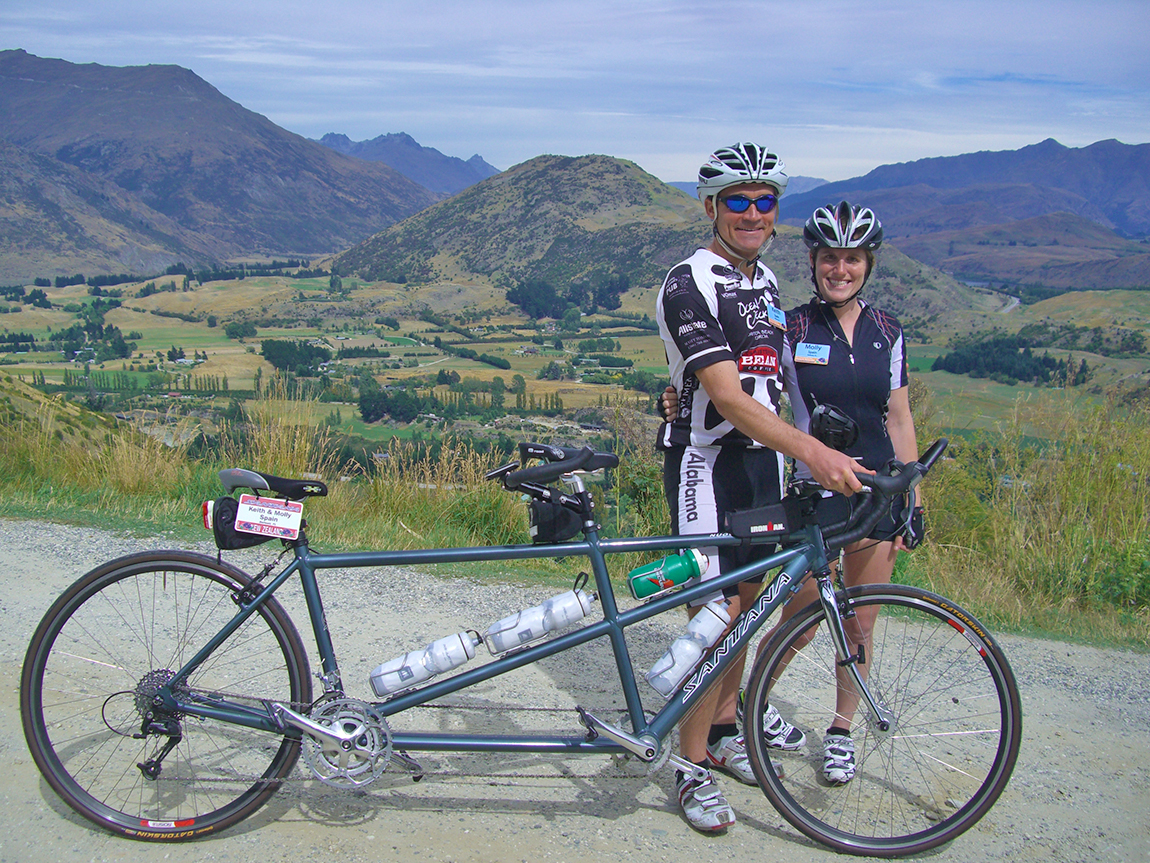
SECTION TWO
Traveling with a coupled tandem
All others can skip to Section Three
8. Lose the attitude
At the time of their debut, proponents of S&S couplers talked about “getting even” with airlines who, barely a decade earlier, had initiated a charge for bicycles. Many who invested in this technology felt cheated when airlines started charging for all suitcases. Even now, we sometimes hear from S&S owners who are still angry over this issue. Unless you want to be hassled, overcharged, or turned away, don’t go to the airport with a chip on your shoulder.
9. Suitcase vs. bike case
S&S-brand cases, designed to meet an old and rarely enforced regulation, have never looked like normal suitcases. After 15 years (and thousands of cases) a significant number of airline employees now realize that these distinctively thin and square cases hold a bicycle. When they spot your S&S bicycle case, an “aware” agent may impose a higher “bike fee” instead of the expected “suitcase fee.”
While this may seem unfair (especially when larger cases that are normally proportioned won’t be spotted) agents who assess this fee are usually correct. While a few airlines have recently made a point of waiving bike fees for bikes that fit in a single S&S case, most haven’t. By their rules a bike is a bike. Their employees are expected to collect the bike fee when they spot a bike, even if the case is tiny.
We’ve now received reports from five couples who paid twice the single bike fee to check a tandem packed into two S&S cases. In these instances (different airlines and airports) the check-in agent spotted two bike cases, charged two bike fees, and failed to be dissuaded.
My advice is to not worry. Most agents won’t levy bike fees for a small cases. If you’re asked to pay, remain calm and question it once. Then pay the doubled fee without further fuss. My clear instruction to ”pay instead of complaining” is covered in Section Three.
10. Pack smart.
Although airline agents won’t bother to measure a suitcase (which is explained later), checked luggage is always counted, and usually weighed. Try to keep each suitcase below the 50-pound limit that (since 2003) can trigger an upcharge. If you need to pack a bit more, the 50-70 pound overweight fee is often waived, and may be cheaper than an extra case fee.
Using one of the ATM style check-in kiosks may save you some money. Just type in the correct number of suitcases. When the clerk arrives with the right number of tags, they’re unlikely to comment if your bag is a bit large or heavy.
11. “Should I expect to pay an extra fee when checking a moderately oversized suitcase?
No. But if you pack your tandem into an older SafeCase with removable wheels, you might get dinged with an oversize fee if you forget to remove those wheels BEFORE you lift your case onto the scale (which is explained below).
12. “I’ve heard elsewhere that airlines charge extra for a “non-regulation” case!”
Decades ago someone came up with the arcane 62-inch rule. Most check-in agents don’t even know this rule exists. Unless you show up late or have an attitude, airline employees who know about the 62-inch regulation won’t bother to enforce it.
13. “Shouldn’t I worry about the size of my tandem SafeCase?”
In spite of stern warnings you’ve heard (probably from someone who’d love to sell you a pair of smaller cases), there’s no need to worry. If you don’t believe me, measure your trusty carry-on case and compare those measurements with the published dimensions of a “regulation” under seat bag. Truth is, thousands of oversize suitcases are traveling through airports every day without causing a hassle or triggering an extra charge.
14. “Others have sworn my case will be measured!”
When someone first warned me of the 62-inch rule, I measured the suitcases Jan and I had been checking for years. Our motley collection of gusseted cordura suitcases (purchased at Wal-Mart and Target) all exceeded 62 inches! Not only had our cases never been measured, millions of others were travelling with dimensionally identical luggage. Later, reacting to tip received from the inventor of S&S couplers, we learned that suitcases sold overseas (and at U.S. swap meets) were exactly the same height as an S&S case—but a few inches longer. Once I knew what to look for, I spotted dozens of these taller “third-world” suitcases every time I went through a large airport. In the mid ‘90s Santana found an importer for these cases and included them with the purchase of a coupled tandem. Once we confirmed that these non-regulation cases didn’t cause so much as a raised eyebrow, we designed our SafeCase with these same “flight-tested” dimensions. Jan and I have traveled with “non-regulation” luggage for over 25 years. In the 15 years Jan and I have traveled with a SafeCase (over 100 check-ins) we’ve had an agent measure it exactly three times. One said “close enough,” another winked and the third charged us $80. On average, we’ve paid an extra 80 cents per flight to check a case that exceeds the 62-inch rule.
15. “Since they already weigh suitcases, won’t airlines start measuring them?”
Here’s why that won’t happen. Because they get you to lift your luggage onto their scale, weighing a suitcase is too easy. To measure a suitcase, however, an agent will have to climb off their stool, find a tape measure, wrestle with your case, write down two measurements, wrestle with your case some more, record the remaining measurement, and then manually add three numbers. Instead of being trained to perform this inefficient procedure, agents are instead trained to use visual “cheat marks” on their scale’s backstop and platform. Agents know through training that items which obscure one or more of these visual cues may jam the conveyor belt system that delivers checked baggage to a remote staging area. When a case obscures a cheat mark (which happens if you forget to remove wheels from an older SafeCase), it is essential that the agent set it aside before paging a baggage handler to cart the “oversize” item through the terminal. The “oversize” fee is totally unrelated to the size of an airplane. It is instead a reasonable charge for the special handling required when an item might jam a terminal’s automated luggage system (which could cause a string of late departures). Since a SafeCase was designed to fit through TSA scanners and terminal conveyor systems, it won’t obscure cheat marks or trigger a fee for special handling. By the accepted definition used in airport terminals a SafeCase is NOT oversize. Because a SafeCase won’t jam their system, if they ask “Is it oversize?” an honest reply will be “No.”
16. “Why would airlines publish a 62-inch rule if they won’t enforce it?”
Instead of publishing a complex set of measurements for each peculiar shape (i.e. suitcases, duffels, backpacks, gun cases, strollers, framed art, etc.) the airlines use 62 inches as a universal measurement that serves to notify passengers that larger items may trigger a fee for special handling. As long as the combined dimensions fall within 62 inches, even an item the shape of a cue-stick or an artist’s folio cannot jam the airport’s automated conveyor systems. A normally proportioned suitcase would need to be much larger than 62-inches to jam these same systems.
17. Surprise: a “bike” might be cheaper than checking a suitcase—U.S. Example
A welcome trend from Europe is a reversion to sporting equipment rates (and bike fees) that are cheaper than normal suitcase rates. While this is still rare in the U.S., we note that Southwest charges less for a tandem in a huge shipping carton than they do for a third suitcase. When you go to the web to check fees, you’ll need to dig past “luggage regulations” to find the rates for checked “sporting equipment.” My European example in the following section shows how a bike fee can be hundreds of dollars less than hiding your tandem inside one or two suitcases.
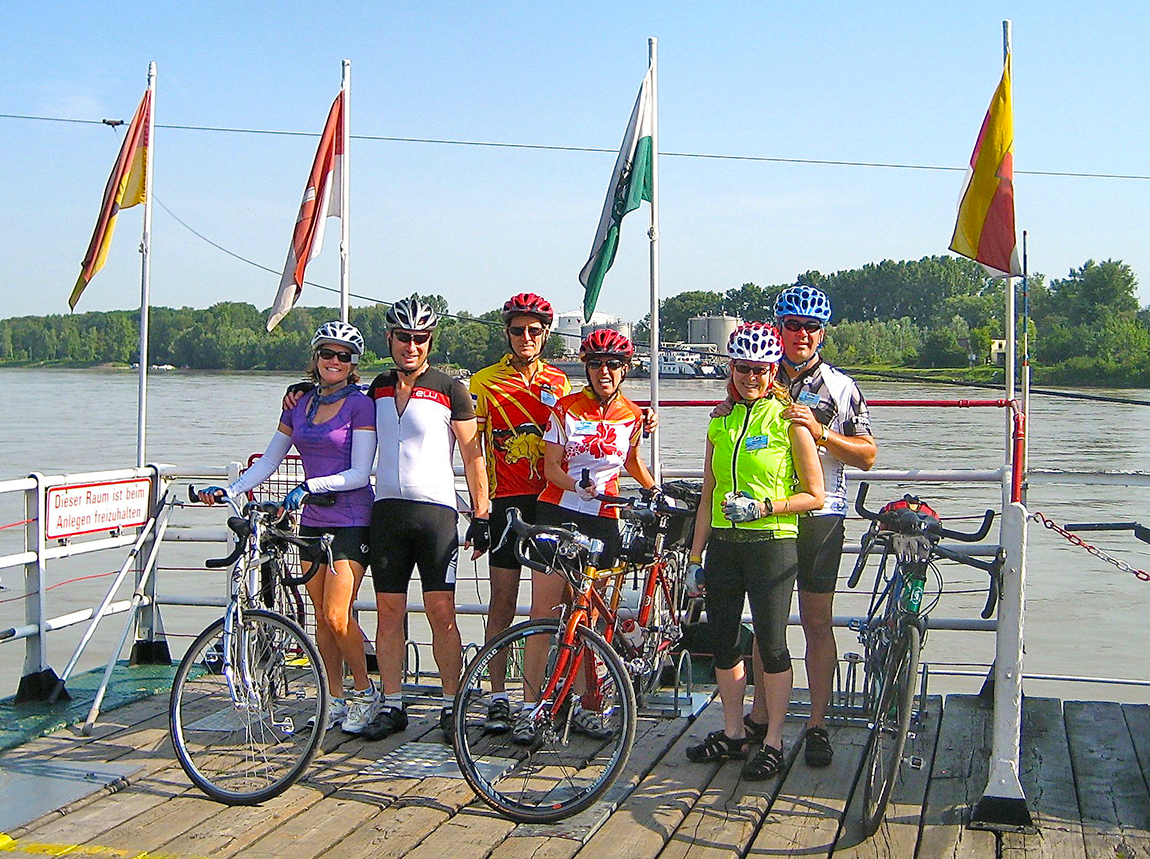
SECTION THREE
Knowing the ropes
Applies to all will fly with any bike
18. New 3-case per-passenger limits
Unless your originating flight is on a small plane or a regional jet, ignore the new rules that limit passengers to 3 checked items. This new rule (like the much older 62-inch regulation) is almost always a “won’t be enforced” issue. In this case airlines are trying to limit the ugliness that occurs when their tiny regional jets can’t accommodate the luggage that passengers present at the check-in counter; often at the last minute. Instead of a complex explanation they use this simple catch-all (like the 62-inch rule) so they can claim “fair warning” when passengers become angry. If you check in early (and it’s not December), you won’t be affected when your originating flight uses one of these smaller planes.
19. Early is always better
After too many tense check-ins, Jan and I changed strategy and made early check-in a ritual. We’re calmer. Lines are shorter. Check-in agents are less pressured. We now advise others to show up early. It not only prevents anxiety and aggravation, it may lower the total fees you’ll be asked to pay. After checking in and getting through security, we find a quiet spot to catch up on the e-mail and phone calls we missed the previous day. Since airlines no longer provide free meals, a leisurely meal after check-in is today’s smartest way to travel.
20. Be charming.
Since the check-in agent can ignore existing rules (or make up new ones), why not SMILE and be the nicest customer they’ve encountered all week? I always go through the entire ID, frequent flier, and seat assignment pleasantries BEFORE baggage is ever mentioned.
21. Don’t cause a scene
When flying to tandem rallies and tours (4-6 annually for the past decade), Jan and I often take 3 or 4 full-sized tandems plus 5 or 6 suitcases. While we almost always pay some extra fees, it’s usually less than the published tariff. But after an agent explains their calculation (I always ask nicely), I simply pull out the credit card. If I thought the charge was too high (which has never happened!), I’d pay without further complaint at the airport. Later, if their website supported my belief, I’d write a short letter to the airline respectfully asking them to “adjust” their mistake. And if the airline does not respond to such a request, you could legitimately ask your credit card company to reverse the charge.
Yes, even if the agent asks for an outrageous sum, my advice is to pay it without complaint.
Getting angry with the agent—never a good strategy—is especially ill-advised with today’s heightened security. Even if your first instinct is to raise a fuss, don’t. Similarly, asking for an agent’s name so you can report them to management may cause them to tag you as a disruptive or bullying passenger—a report that could haunt you for years. Finally, after they receive your nice letter, the airline is far more likely to adjust a questionable charge in your favor if the check-in agent hasn’t logged an “unruly” code into your record.
22. Don’t phone the airline.
If they tell you “no” and attach a memo to your reservation, the agent at the counter will feel obliged to turn you away. Can’t you phone anonymously? When you call their toll-free number, computers at the other end of the airline’s phone will attempt to identify you, and will often display your file to the agent. If any airline employee decides to tag you as a “troublesome” passenger, you can anticipate years of problems.
23. Avoid tight connections
As you shop for tickets, don’t choose flights with tight connections at busy hubs. Even if your originating flight arrives on time, your bike is apt to miss a 60-minute connection. When connecting overseas (where airlines aren’t graded for delayed luggage) I avoid connections tighter than 90-minutes (especially when connecting between two carriers).
24. Check your luggage to your final destination.
A few years ago I took a last-minute short-hop flight on one airline to reach a long-haul flight I’d purchased months earlier from a different airline. When the hop was delayed, and I asked the flight attendant how long it would take me to reclaim and re-check my luggage, she let me in on something the airlines won’t tell you. If you show both tickets at check-in (and the time between flights is less than six hours), an airline is obliged to check your luggage to your final destination. I’ve since tested her report, and can verify that it works! This tip will not only save you a second set of fees, if the airport where you’re changing airlines is large (ie: LAX, JFK, London or Paris), you won’t be weighed down with luggage as you make your way to a distant terminal.
25. Don’t get tripped up by layovers
Americans flying to Europe can often find a “free layover” deal that includes a day or two in Paris or London. They’re later surprised when they pay to recheck their luggage (and may pay higher fees for their intra-Europe hop than they did for their transatlantic jump).
Similarly, transpacific flights often entail an overnight layover in San Francisco or LA. If you decide to check some or all of your luggage only as far as a layover point, be prepared pay again for any item you recheck the following morning.
26. Employ a willing ally
When curbside help is available, Jan and I always flash some cash while trying to check our bags and tandem(s) with a sky-cap or porter. On the way back from a recent tour in Hawaii a $60 tip caused a porter to shepherd four boxed tandems plus four overweight suitcases through the TSA and agricultural-inspection lines before asking me to give him my credit card so he could “let me relax” while he checked my stuff at a remote counter. When he returned to have me sign the slip, my total fee for 4 tandems and 4 oversize suitcases was $80. While most porters won’t be this accommodating, even when they only go so far as to escort you inside, I’ve learned that airline counter agents (who don’t take tips but do assess fees) will often provide better treatment to passengers who have tipped porters. Does this make sense? Sure. Airline check-in agents rely on the overworked and poorly-paid porters to help them process crowds and get planes dispatched on time. Treating a sky-cap’s clients poorly, and depriving these helpers of their source of tips, would be unthinkable.
So whenever you have a choice, find and use a porter to help you with check in. While the agents at the counter cannot accept tips, a sky-cap who spots your cash will instantly understand your desire for “superior customer service.”
27. Southwest Loves Tandems
While most of the large airlines tend to move with the herd, Southwest takes pride in being contrarian. When others adopted fees for formerly free suitcases, Southwest attracted new business with their “suitcases fly free” ad campaign. Similarly, as other airlines made it tougher to fly with sporting equipment, Southwest dropped their bicycle fee to $75 (and allows a weight of up to 100 pounds). Before anyone phones me to report that Southwest’s web site claims they will turn away sporting items exceeding 80-inches, please note that the same section of their website specifically allows vaulting poles, which are always much longer. Again, unless provoked, Southwest’s check-in agents won’t look for ways to prevent courteous couples from checking tandems onto one of their roomy 737s.
28. Will Delta turn away tandem owners?
A few years ago Delta’s list of luggage fees was changed to specify “single seat” bicycles. This terminology, still present, has caused scores of tandem owners to contact Santana for advice. A few months later, United posted a ban against “tandem bicycles.” Although United quickly reversed course (and now specifically invites tandems!) this short-lived ban caused Santana to field additional calls. My advice to all tandem owners is to ignore all senseless regulations found on any airline’s website. Punishing Delta or themselves because of a ridiculous regulation, or imagining that any airline will turn away a courteous couple because of their tandem, is silly.
29. “This whole baggage fee issue seems so confusing”
Here’s the simple version for U.S. check-in: Airline agents will always need to count bags in order to create the same number of bar-coded tags. Because their count is easy to audit, check-in agents will usually charge you for every item you check. In the U.S. most agents are not required to log the weight of your bags. Still, as your bag crosses the scale, they are now supposed to tag everything over 50 pounds to prevent workers’ comp claims. Even when they add the extra tag, agents sometimes do this without comment or charge. Unless the item is a lot bigger than a normal suitcase, size is ignored. If an item is as large as a normal bike case, they’ll page a baggage handler (which justifies their fee for accepting your bike).
In Europe it’s different; and often worse. On flights within Europe many airlines are now charging by the kilo for all luggage including carry-on. After providing a small number of kilos for free, they weigh everything you’re not wearing (even purses and computers). The excess weight fee of up to 20 Euros per kilo (which is over $10 per pound) is so high that in European airports you’ll see people bundled in layers of clothing, with extra shoes hanging out of their pockets. Under these rules a tandem packed in two S&S hard cases will be at least $100 more expensive than the same tandem packed in a SafeCase. Will this practice spread to the U.S.? Impossible to predict.
30. Always check fees for Sporting Equipment—European Example
When an agent quotes a high price to check your hidden tandem, why not ask “Would it be less if I was checking a bicycle?” My example is a Swiss flight Jan and I took between Spain and Zurich. After checking a minimal allotment of free luggage plus a tandem packed in pair of S&S cases (with a gross weight of 88 lbs), the normal luggage fee for our “hidden” bike added about 600 euro (about $800). When told it was a tandem the check-in agent lowered the fee for both cases to 70 Euros (about $100). Swiss, by the way, not only has great rates for bikes, their definition of a bike specifically includes tandems.
31. Why do airlines write regulations against bicycles or tandems?
Almost all of the past, current and future anti-bike fees and rules were written by airlines as a reaction to a small number of bike riders who have caused problems. The posted accounts written by cyclists who were “turned away” or “had to put up a fight” may not tell the whole story. Why is it, do you suppose, that these same posts can reveal an arrogant and/or belligerent attitude? If they posted the whole story we’d find that most scare stories are written by those who showed up too late, ticketed themselves onto a plane that was too small, or disrupted check-in with a loud and/or prolonged argument about fees.
32. If you followed these tip and still have trouble…
Stay calm and polite, but don’t walk away. Instead of demanding to see a supervisor, ask nicely if there’s anyone who can help you. Remind them it’s a special vacation. Look sad!
If you follow all these tips and miss a flight (which won’t happen), or if you discover a new strategy for easy tandem check-in, my e-mail is bill@santanatandem.com
33. Has flying with a tandem become too difficult or expensive?
It only seems difficult because airlines are struggling to survive in an era of internet fare wars where their frequent choice is to sell seats below-cost, or have planes fly empty. If airlines can’t cover costs with airfare, they’ll charge extra for everything else. While checking luggage has therefore become pricey, the total cost for flying with a bicycle is cheaper today than it was a decade ago. Because tandems almost always fly for the price of a single bike, vacationing with your tandem is the best bargain of all.
34. The best way to prevent problems and save money
Airline luggage rules have recently changed in unpredictable ways. Fees will continue to change as airlines learn how to increase revenue while selling seats in an internet-driven environment. Because the “bean counters” at corporate headquarters have made check-in confusing and restrictive, employees at check-in counters have increasingly reacted by siding with passengers instead of researching and applying the onerous “regulations” that make their jobs less pleasant. Additionally, many of these overworked agents may resent collecting new fees for the same management that recently cut their pay or benefits. As a result, the price tandem owners pay to check their bike (which was always unpredictable) has become less and less a function of rules, weights and case sizes—and is increasingly a reflection of your personal demeanor. Does this make sense? Sure. Airport check-in agents have a thankless job, and are often mistreated. While they can’t lash back at those who abuse them, they can receive a sense of job satisfaction by rewarding passengers who are exceptionally nice. At airport check in Jan and I are charming, smiling and friendly. We also work very hard to make sure we arrive early, and in a good mood. If you show up at the airport late, unprepared, frowning, or with a chip on your shoulder, you may pay more to check your luggage; and you might be prevented from checking your tandem
– Bill McCready, Founder and President Santana Cycles, Inc.

